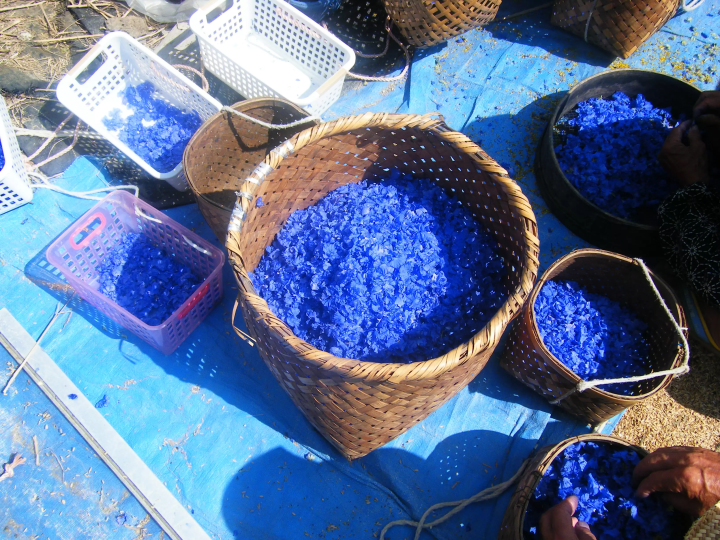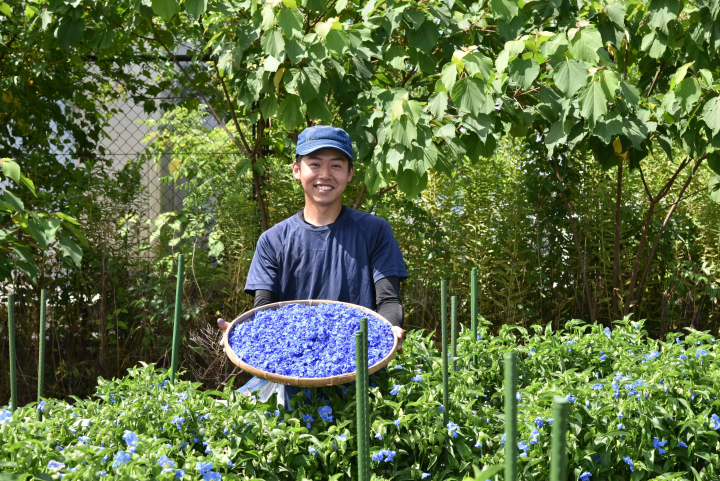Save the Flowers of Hell! Experience the passion of a young challenger

"Aobana" has been cultivated only in Kusatsu City, Shiga Prefecture and the surrounding area. It is also called "Hell's Flower" because of the difficulty of cultivation. We will introduce young people who continue to protect and further develop this flower that has been handed down since ancient times.
"Aobana" teaches us the wonder of the earth's blessings
Aobana is a type of dayflower that blooms in vivid cobalt blue flowers from July to August, the hottest month of the year.
Since the Edo period, it has been cultivated as a raw material for paints used in Yuzen dyeing, tie-dyeing, ukiyo-e, etc., and in 1981 it was designated as the flower of Kusatsu City.

The buds open with the rising of the sun
Early in the morning, as the sun rises the aobana buds begin to open.
The blue-and-white hedge, the largest of which can reach 5 shaku (150 cm) in height, will eventually be covered with small, dotted blue flowers.
I pick them carefully one by one, being careful not to get any yellow pollen on them, but what's strange is that even though I've picked most of the flowers the day before, by the next day they're back to normal, with new flowers blooming somewhere.
It's called "Hell Flower"
For over a month, Aobahana farmers have been chasing the eye-catching blue every day, rain or wind.
Under the strong summer sun, the bluebells bloom every day and must be picked by noon.
Once the picking is finally completed, the juices must be squeezed forcefully by hand before being processed.
Because of the difficulty of this work, the blue-flower eventually came to be known as the "hell flower."
Ideal for sketching Yuzen dyeing
As its name suggests, Aobana has a beautiful blue color. People often mistakenly think that this is used for dyeing, but
In fact, the pigment of Aobana is easily soluble in water and is not suitable for dyeing.
However, this property of disappearing when exposed to water has been taken advantage of and it has come in handy as a way to draw the preliminary sketches before applying patterns to Yuzen-dyed fabric.

Now there is only one
And the cultivation of Aobana flourished along with the production of kimonos using Yuzen dyeing.
At its peak, there were many Aobana farms lined up along the street, some of whom even said they built their homes out of Aobana.
However, as time passed, the demand for kimonos decreased and the Seika paper industry began to decline.
Then, with the advent of chemical blue and white paper, which scientifically reproduces the characteristics of aobana, the aobana fields that once decorated the shores of Lake Biwa have almost disappeared. Today, there is only one farmer left who still produces traditional aobana paper, and there is no one to take over.
I want to protect Aobana.
"They used to bloom profusely."
Aobana has come to be spoken of like a fairy tale.
Even though it is the city's flower, most people have never actually seen it in bloom.
Aobana, which has been grown by humans for hundreds of years, is an industrial plant and will revert to its original shape when it grows wild.
However, no matter how hard we try to grow aobana, there are only a few sources to supply it.
In order to save Aobana, the industry itself needs to be revived.
Then one young man stood up.
His name is Takayoshi Minematsu.

He discovered Aobana by chance, and the following year he learned about Aobana cultivation methods and the culture behind it from the late Shigeo Nakamura, who was 89 years old at the time and was an Aobana farmer who was awarded the Yellow Ribbon Medal for his many years of achievements.
For the next two years, he visited the house every day during the aobana season and picked aobana with the family, and in 2019 he acquired the farmland.
He started farming as an Aobana farmer with no prior experience.
Now that his master Shigeo has passed away, he keeps in his heart the words of his master, "I've entrusted Aobana to you," and continues to work on cultivation, research, and spreading the culture of Aobana.
Currently, the company is the largest producer of Aobana flowers in Kusatsu City.
Carrying the future of Aobana
Minematsu has now established the non-profit organization Aobana Seisai, where he is working hard to preserve and further utilize Aobana.
Many people gather at Minematsu's field to pick aobana.
Tourists, local farmers, housewives getting ready for the morning, seniors, people with disabilities, and above all, children on summer vacation...
You will surely never forget the blue petals you picked up.
It is easy to imagine that the sight of many people chasing the blue in the summer sunshine on the shores of Lake Biwa is one of the most special sights in the prefecture.
I hope that these forgotten flowers can once again become a treasure for the citizens.
That's what Minematsu said.
The day when the flower that was once called hell will be called heaven may not be so far away.
[Contact Information]
NPO Seika Seisai
1-18-32 Oji, Kusatsu City, Shiga Prefecture, 525-0032
This site introduces tourist information for Kusatsu City, Shiga Prefecture. It is packed with information on attractive spots, hotels, and gourmet food, such as the nature-filled aquatic plant park Mizunomori, Lake Biwa Museum, the historic Tachiki shrine and the Sandai shrine, Kusatsujuku Honjin, and Rokuha Park, which is fun for the whole family.
The contents on this page may partially contain automatic translation.

































![[2026 Edition] FORMUAL 1 JAPANESE GRAND PRIX Information](https://resources.matcha-jp.com/resize/720x2000/2025/10/05-245984.webp)


![[2025 Update] Namba's spectacular illuminations! "Namba Hikari Tabi" with approximately 1 million shining lights](https://resources.matcha-jp.com/resize/720x2000/2025/12/12-252825.webp)